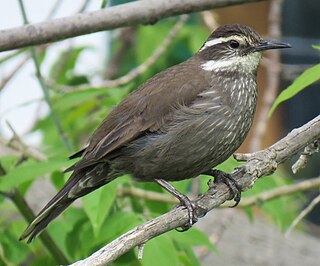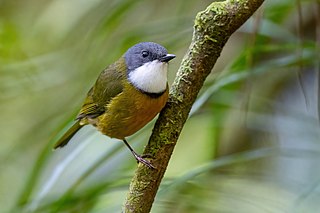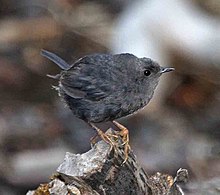
The black wheatear is a wheatear, a small passerine bird in the Old World flycatcher family Muscicapidae. It is found in southern Spain and western North Africa.

The eyebrowed thrush is a member of the thrush family Turdidae. It breeds in dense coniferous forest and taiga eastwards from Siberia and Mongolia to Japan. It is strongly migratory, wintering south to China and Southeast Asia. It is a rare vagrant to western Europe.

The striated pardalote is the least colourful and most common of the four pardalote species. Other common names include pickwick, wittachew and chip-chip. It is a very small, short-tailed bird that is more often heard than seen, foraging noisily for lerps and other small creatures in the treetops.

The rock shag, also known as the Magellanic cormorant, is a marine cormorant found around the southernmost coasts of South America. Its breeding range is from around Valdivia, Chile, south to Cape Horn and Tierra del Fuego, and north to Punta Tombo in Argentina. In winter it is seen further north, with individuals reaching as far as Santiago, Chile on the west coast and Uruguay on the east. The birds also breed around the coasts of the Falkland Islands.

The capped wheatear is a small insectivorous passerine bird that is widely distributed over southern Africa. It was formerly classed as a member of the thrush family Turdidae, but is now placed in the Old World flycatcher family, Muscicapidae.

The red-throated parrotfinch is a species of estrildid finch found in New Caledonia. It has an estimated global extent of occurrence of 20,000 to 50,000 km2.

The New Zealand pipit is a fairly small passerine bird of open country in New Zealand and outlying islands. It belongs to the pipit genus Anthus in the family Motacillidae.

The red-and-black grosbeak is a species of bird in the family Cardinalidae, the cardinals or cardinal grosbeaks. It is found in Brazil, French Guiana, Guyana, Suriname, and Venezuela.

The dark-sided flycatcher is a small passerine bird belonging to the genus Muscicapa in the Old World flycatcher family Muscicapidae. It has a wide breeding distribution in the East Palearctic with northern birds migrating south for the winter. It is also known as the Siberian flycatcher or sooty flycatcher, the latter name is also used for the sooty flycatcher of Africa.

The straw-headed bulbul is a species of songbird in the bulbul family, Pycnonotidae. It is found from the Malay Peninsula to Borneo. Its natural habitats are subtropical or tropical moist lowland forest, subtropical or tropical mangrove forest, subtropical or tropical moist shrubland, arable land, plantations, and rural gardens. It is threatened by habitat loss and poaching.

The black-faced ibis is a species of bird in the family Threskiornithidae. It is found in grassland and fields in southern and western South America. It has been included as a subspecies of the similar buff-necked ibis, but today all major authorities accept the split. The black-faced ibis also includes the Andean ibis as a subspecies. Some taxonomic authorities still do so.

The cinnamon attila is a species of bird in the family Tyrannidae, the tyrant flycatchers. It is found in northern South America in the Amazon Basin of Brazil and the Guianas. It is found in Brazil, Colombia, Venezuela, Guyana, Suriname, and French Guiana; also Amazonian Ecuador, Peru, and regions of Bolivia. Its natural habitat is subtropical or tropical swamps.

The dark-bellied cinclodes is a species of bird in the Furnariinae subfamily of the ovenbird family Furnariidae. It is found in Argentina and Chile.

The pale thrush is a passerine bird of the eastern Palearctic belonging to the genus Turdus in the thrush family Turdidae. It is closely related to the eye-browed thrush and grey-backed thrush.

The Vanuatu white-eye or yellow-fronted white-eye is a small passerine bird belonging to the genus Zosterops in the white-eye family Zosteropidae. It is endemic to Vanuatu, where it is one of the most common birds.

The grey tit is a species of bird in the tit family Paridae. It is found in Lesotho and South Africa. Its natural habitats are subtropical or tropical dry shrubland and Mediterranean-type shrubby vegetation.

The white-eyed thrush is a species of bird in the family Turdidae that is endemic to Jamaica. Its natural habitats are subtropical or tropical moist lowland forests, subtropical or tropical moist montane forests, and heavily degraded former forest.

The eastern yellow wagtail is a small passerine in the wagtail family Motacillidae, which also includes the pipits and longclaws. It was often classified as a subspecies of the Western yellow wagtail. It breeds in the eastern Palearctic and Alaska and migrates to South Asia and Australia.

The Hawaiʻi ʻelepaio, also Hawaiian ʻelepaio, is a monarch flycatcher found on the Big Island of Hawaii. Until 2010, all three ʻelepaio species, the Kauaʻi ʻelepaio, the Oʻahu ʻelepaio and this species were considered conspecific.

The New Caledonian whistler is a species of bird in the family Pachycephalidae. It is endemic to New Caledonia.























